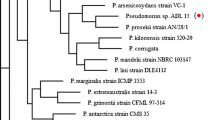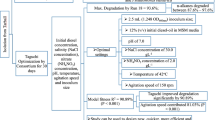Abstract
Efficiency of Enterobacter cloacae KU923381 isolated from petroleum hydrocarbon contaminated soil was evaluated in batch culture and bioreactor mode. The isolate were screened for biofilm formation using qualitative and quantitative assays. Response surface methodology (RSM) was used to study the effect of pH, temperature, glucose concentration, and sodium chloride on diesel degradation. The predicted values for diesel oil degradation efficiency by the statistical designs are in a close agreement with experimental data (R 2 = 99.66%). Degradation efficiency is increased by 36.78% at pH = 7, temperature = 35°C, glucose = 5%, and sodium chloride concentration = 5%. Under the optimized conditions, the experiments were performed for diesel oil degradation by gas chromatographic mass spectrometric analysis (GC-MS). GC-MS analysis confirmed that E. cloacae had highly degrade hexadecane, heptadecane, tridecane, and docosane by 99.71%, 99.23%, 99.66%, and 98.34% respectively. This study shows that rapid bioremoval of hydrocarbons in diesel oil is acheived by E. cloacae with abet of biofilm formation. The potential use of the biofilms for preparing trickling filters (gravel particles) for the degradation of hydrocarbons from petroleum wastes before their disposal in the open environment is highly suggested. This is the first successful attempt for artificially establishing petroleum hydrocarbon degrading bacterial biofilm on solid substrates in bioreactor.
Similar content being viewed by others
References
Ameen, F., Moslem, M., Hadi, S., and Al-Sabri, A.E. 2016. Biodegradation of diesel fuel hydrocarbons by mangrove fungi from Red Sea Coast of Saudi Arabia. Saudi J. Biol. Sci. 23, 211–218.
Annuar, M.S.M., Tan, I.K.P., Ibrahim, S., and Ramachandran, K.B. 2006. Ammonium uptake and growth kinetics of Pseudomonas putida PGA1. Asia Pac. J. Mol. Biol. Biotechnol. 14, 1–10.
Bakkiyaraj, S., Syed, M.B., Devanesan, M.G., and Thangavelu, V. 2015. Production and optimization of biodiesel using mixed immobilized biocatalysts in packed bed reactor. Environ. Sci. Pollut. Res. Int. 15, 4583–4587.
Bodour, A.A. and Maier, R.M.M. 1998. Application of a modified drop-collapse technique for surfactant quantitation and screening of biosurfactant-producing microorganisms. J. Microbiol. Methods 32, 273–280.
Chang, R. 1998. Chemistry. Sixth (ed.) McGraw Hill Company.
Christensen, G.D., Simpson, W.A., and Younger, J.A. 1995. Adherence of coagulase negative Staphylococci to plastic tissue cultures: a quantitative model for the adherence of Staphylococci to medical devices. J. Clin. Microbiol. 22, 996–1006.
Cooper, D.J. and Goldenberg, B.G. 1987. Surface active agents from two Bacillus species. Appl. Environ. Microbiol. 54, 224–229.
Dave, B.P., Ghevariya, C.M., Bhatt, J.K., Dudhagara, D.R., and Rajpara, R.K. 2015. Enhanced chrysene degradation by a mixed culture biorem-CGBD using response surface design. Indian J. Exp. Biol. 53, 256–263.
Debasmita, N. and Rajasimman, M. 2013. Optimization and kinetics studies on biodegradation of atrazine using mixed microorganisms. J. Alexandria Eng. 52, 499–505.
Donio, M.B.S., Ronica, F.A., Viji, V.T., Velmurugan, S., Jenifer, J.A., Michaelbabu, M., Dhar, P., and Citarasu, T. 2013. Halomonas sp. BS4, A biosurfactant producing halophilic bacterium isolated from solar salt works in india and their biomedical importance. Springerplus 2, 149.
El-Bestawy, E., Sabir, J., Mansy, A.H., and Zabermawi, N. 2014. Comparison among the efficiency of different bioremediation technologies of atrazine–contaminated soils. J. Bioremed. Biodeg. 5, 5.
Ganesh, A. and Lin, J. 2009. Diesel degradation and biosurfactant production by Gram-positive isolates. Afr. J. Biotechnol. 8, 5847–5854.
Geetha, S.J., Joshi, S.J., and Shailesh, K. 2013. Isolation and characterization of hydrocarbon degrading bacterial isolate from oil contaminated sites. APCBEE Procedia 5, 237–241.
Goyal, P., Sharma, M.P., and Jain, S. 2012. Optimization of esterification and transesterification of high FFA Jatropha curcas oil using response surface methodology. J. Petrol. Sci. Res. 1, 36–43.
Holt, J.G., Krieg, N.R., Sneath, P.H.A., Staley, J.T., and Williams, S.T. 1994. Bergey’s Manual of Determinative Bacteriology, 9th edn. Williams & Wilkins. Baltimore, MD, USA.
Kumar, V., Sharma, H.K., Singh, K., and Singh, R.P. 2015. Optimization of process parameters for the production of taro chips using RSM with fuzzy modelling. J. Food Meas. Charact. 9, 400.
Kuntiya, A., Nicolella, C., Pyle, L., and Poosaran, N. 2005. Effect of sodium chloride on cell surface hydrophobicity and formation of biofilm in membrane bioreactor. Warasan Songkhla Nakharin. 27, 1073–1082.
Laxmi, N.P., Mutamed, M.A., and Nagendra, P.S. 2011. Effect of carbon and nitrogen sources on growth of Bifidobacterium animalis Bb12 and Lactobacillus delbrueckii ßsp. bulgaricus ATCC 11842 and production of ß-galactosidase under different culture conditions. Int. Food Res. J. 18, 373–380.
Leahy, J.G. and Colwell, R.R. 1990. Microbial degradation of hydrocarbons in the environment. Microbiol. Rev. 54, 305–315.
Magesh, H., Kumar, A., Alam, A., Priyam Sekar, U., Sumantran, V.N., and Vaidyanathan, R. 2013. Identification of natural compounds which inhibit biofilm formation in clinical isolates of Klebsiella pneumonia. Indian J. Exp. Biol. 51, 764–772.
Mariano, A.P., Bonotto, D.M., Angelis, D.F., Pirô llo, M.P.S., and Contiero, J. 2008. Biodegradability of commercial and weathered diesel oils. Braz. J. Microbiol. 39, 133–142.
Moghadam, M.S., Gholamhossein, E., Behrooz, A., and Alireza, G. 2013. Isolation, identification, and optimization of phenanthrene degrading bacteria from the coastal sediments of nayband Bay. Jundishapur J. Microbiol. 6, 13816.
Natalia, R.R., Menendez, J.A., and Arenillas, A. 2014. Optimization of the process variables in the microwave-induced synthesis of carbon xerogels. J. Sol-Gel. Sci. Technol. 69, 488–497.
Perfumo, A., Smyth, T.J.P., Marchant, R., and Banat, I.M. 2010. Production and roles of biosurfactants and bioemulsifiers in accessing hydrophobic substrates, In Timmis, K.N. (ed.). Handbook of Hydrocarbon and Lipid Microbiology, pp. 501–1512. Springer, UK.
Prakash, B. and Irfan, M. 2011. Pseudomonas aeruginosa is present in crude oil contaminated sites of Barmer Region (India). J. Bioremed. Biodegrad. 2, 5.
Price, A.R.G., Sheppard, C.R.C., and Roberts, C.M. 1993. The Gulf: its biological setting. Mar. Pollut. Bull. 27, 5–15.
Rao, M.A., Scelza, R., Scotti, R., and Gianfreda, L. 2010. Role of enzymes in the remediation of polluted environments. J. Soil Sci. Plant Nutr. 10, 333–353.
Riser-Roberts, E. 1992. Bioremediation of petroleum contaminated sites. CRC Press Inc., Boca Raton, FL,USA.
Saadoun, I. 2002. Isolation and characterization of bacteria from crude petroleum oil contaminated soil and their potential to degrade diesel fuel. J. Basic Microbiol. 42, 420–428.
Sadiq, M., Saeed, T., Fowler, S.W., Khan, N.Y., Munawar, M., and Price, A.R.G. 2002. The Gulf Ecosystem: health and sustainability. Backhuys Publishers, Leiden, The Netherlands.
Samuel, E.A. and Ogunleye, O.O. 2012. Factorial designs application to study enhanced bioremediation of soil artificially contaminated with weathered bonny light crude oil through biostimulation and bioaugmentation strategy. J. Environ. Protect. 3, 748–759.
Sanyaolu, A.A., Sanyaolu, V.T., Kolawole-Joseph, O.S., and Jawando, S.S. 2012. Biodeterioration of premium motor spirit (PMS) by fungal species. Int. J. Sci. Nat. 3, 276–285.
Sarve, A., Sonawane, S.S., and Varma, M.N. 2015. Ultrasound assisted biodiesel production from sesame (Sesamum indicum L.) oil using barium hydroxide as a heterogeneous catalyst: comparative assessment of prediction abilities between response surface methodology (RSM) and artificial neural network (ANN). Ultrason. Sonochem. 26, 218–228.
SAS. 1996. SAS user’s guide statistics version 6.12. SAS Institut, Cary, NC, USA.
Satpute, S.K., Bhawsar, B.D., Dhakephalkar, P.K., and Chopade, B.A. 2008. Assessment of different screening methods for selecting biosurfactant producing marine bacteria. Indian J. Mar. Sci. 37, 243–250.
Sriram, M.I., Kalishwaralal, K., Deepak, V., Gracerosepat, R., Srisakthi, K., and Gurunathan, S. 2011. Biofilm inhibition and antimicrobial action of lipopeptide biosurfactant produced by heavy metal tolerant strain Bacillus cereus NK1. Colloids Surf B: Biointerfaces 85, 174–181.
Steel, R.G.D. and Torrie, J.H. 1980. Principles and procedures of statistics: a biometrical approach, second edn. McGraw-Hill, NY,USA.
Sugumar, R., Prabhakaran, M., and Chandran, P. 2014. Characterization and optimization of EPS producing and diesel oil-degrading Ochrobactrum anthropi MP3 isolated from refinery wastewater. Petroleum Sci. 11, 189–199.
Vidhyalakshmi, R. and Vallinachiyar, C. 2012. RSM for accelerated biofilm formation that facilitates bioremediation and characterization of biofilm. GJSFR 12, 546.
Wang, L.Y., Gao, C.X., Mbadinga, S.M., Zhou, L., Liu, J.F., and Gu, J.D. 2011. Characterization of an alkane-degrading methanogenic enrichment culture from production water of an oil reservoir after 274 days of incubation. Int. Biodeter. Biodegr. 65, 444–450.
Wang, Y., Wu, H., and Zong, M.H. 2008. Improvement of biodiesel production by lipozyme TLIM-catalyzed methanolysis using response surface methodology and acyl migration enhancer. Bioresour. Technol. 99, 7232–7237.
Youssef, N.H., Duncana, K.E., Naglea, D.P., Savagea, K.N., Knappb, R.M., and McInerney, M.J. 2004. Comparison of methods to detect biosurfactant production by diverse microorganisms. J. Microbiol. Methods 56, 339–347.
Zafar, M., Kumar, S., and Surendra, K. 2010. Optimization of napthalene biodegradation by a genetic algorithm based response surface methodology. Braz. J. Chem. Eng. 27, 89–99.
Author information
Authors and Affiliations
Corresponding author
Rights and permissions
About this article
Cite this article
Ramasamy, S., Arumugam, A. & Chandran, P. Optimization of Enterobacter cloacae (KU923381) for diesel oil degradation using response surface methodology (RSM). J Microbiol. 55, 104–111 (2017). https://doi.org/10.1007/s12275-017-6265-2
Received:
Revised:
Accepted:
Published:
Issue Date:
DOI: https://doi.org/10.1007/s12275-017-6265-2




